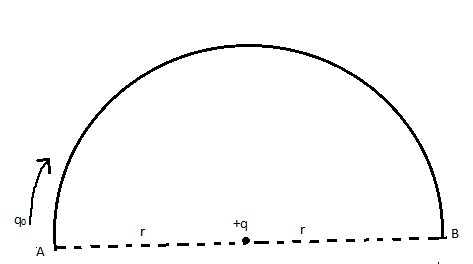
A particle of charges ${q_0}$ is moved around a charge +q along the semicircle path of radius r from A to B (see figure). The work done by the Coulomb force is: 
A) $\dfrac{1}{{4\pi {\varepsilon _0}}}\dfrac{{{q_0}q}}{r}$
B) $\dfrac{1}{{4\pi {\varepsilon _0}}}\dfrac{{2{q_0}q}}{r}$
C) $\dfrac{1}{{4\pi {\varepsilon _0}}}\dfrac{{2{q_0}q}}{r}.\pi r$
D) $Zero$
Answer
218.1k+ views
Hint: The Coulomb force is also called the electrostatic force and is defined as the force of the attraction or repulsion of the particles because of the electric charge.
Complete step by step solution:
Given data:
A particle of charges ${q_0}$ is moved around a charge +q along the semicircle path of radius r.
Then work done by the Coulomb force =?
We know that the work done by the Coulomb force is given by the formula, $w = qV$
The charge ${q_0}$ is moved and the potential due to the charge +q at a distance of r is V.
Thus $V = \dfrac{1}{{4\pi {\varepsilon _0}}}\dfrac{q}{r}$
Thus, Potential at A and B is the same.
Thus substituting the values of q and V, we get,
$W = {q_0} \Delta V$
$ \Rightarrow W = 0$
Hence the correct option is D.
Note: 1. Coulomb’s law states that the force of the attraction or the repulsion between the charged objects will be directly proportional to the product of the charges and is inversely proportional to the square of the distance between the objects.
2. The property of matter that causes it to experience the force when placed in the electromagnetic field is called the Electric Charge. It is of two types namely positive charge and negative charge. The like charges will repel each other and the unlike charges will attract each other.
3. When the matter consists of more number of protons than electrons, then we can say that the electric charge is the positive charge. Similarly, when the matter consists of more electrons than protons, then we can say that the electric charge is the positive charge.
Complete step by step solution:
Given data:
A particle of charges ${q_0}$ is moved around a charge +q along the semicircle path of radius r.
Then work done by the Coulomb force =?
We know that the work done by the Coulomb force is given by the formula, $w = qV$
The charge ${q_0}$ is moved and the potential due to the charge +q at a distance of r is V.
Thus $V = \dfrac{1}{{4\pi {\varepsilon _0}}}\dfrac{q}{r}$
Thus, Potential at A and B is the same.
Thus substituting the values of q and V, we get,
$W = {q_0} \Delta V$
$ \Rightarrow W = 0$
Hence the correct option is D.
Note: 1. Coulomb’s law states that the force of the attraction or the repulsion between the charged objects will be directly proportional to the product of the charges and is inversely proportional to the square of the distance between the objects.
2. The property of matter that causes it to experience the force when placed in the electromagnetic field is called the Electric Charge. It is of two types namely positive charge and negative charge. The like charges will repel each other and the unlike charges will attract each other.
3. When the matter consists of more number of protons than electrons, then we can say that the electric charge is the positive charge. Similarly, when the matter consists of more electrons than protons, then we can say that the electric charge is the positive charge.
Recently Updated Pages
Young’s Double Slit Experiment Derivation Explained

Wheatstone Bridge Explained: Working, Formula & Uses

Chemical Properties of Hydrogen - Important Concepts for JEE Exam Preparation

JEE General Topics in Chemistry Important Concepts and Tips

JEE Atomic Structure and Chemical Bonding important Concepts and Tips

JEE Amino Acids and Peptides Important Concepts and Tips for Exam Preparation

Trending doubts
JEE Main 2026: Application Form Open, Exam Dates, Syllabus, Eligibility & Question Papers

Derivation of Equation of Trajectory Explained for Students

Hybridisation in Chemistry – Concept, Types & Applications

Understanding the Angle of Deviation in a Prism

Understanding Collisions: Types and Examples for Students

Understanding Atomic Structure for Beginners

Other Pages
JEE Advanced Marks vs Ranks 2025: Understanding Category-wise Qualifying Marks and Previous Year Cut-offs

How to Convert a Galvanometer into an Ammeter or Voltmeter

Ideal and Non-Ideal Solutions Explained for Class 12 Chemistry

Degree of Dissociation: Meaning, Formula, Calculation & Uses

Understanding Electromagnetic Waves and Their Importance

Understanding Average and RMS Value in Electrical Circuits




